Early Irish & Scottish Shoes
By Master Gwylym ab Owain, OP, OL, DWS
History
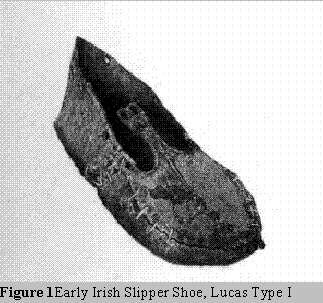 The early Irish were
wont to always wear shoes, as they showed a person's position in society. The more refined shoes were constructed
of leather cut from one piece and were sewn with an ornate seam. The shoes were decorated with interlacing or with
designs cut into the surface of the leather. A number of fine examples of early shoes have been found in bogs.
The one pictured to the right is detailed by Dr. A. T. Lucas in the Journal of the County Louth Archaeological
Society (Vol. XIII, 1956, p. 367). Other shoes similar to this type are shown in Leather Craftsmanship by
Waterer and by I. Marc Carlson on his period footwear web pages. The general date of this type of shoe is from
approximately 700-900 of the Common Era.
The early Irish were
wont to always wear shoes, as they showed a person's position in society. The more refined shoes were constructed
of leather cut from one piece and were sewn with an ornate seam. The shoes were decorated with interlacing or with
designs cut into the surface of the leather. A number of fine examples of early shoes have been found in bogs.
The one pictured to the right is detailed by Dr. A. T. Lucas in the Journal of the County Louth Archaeological
Society (Vol. XIII, 1956, p. 367). Other shoes similar to this type are shown in Leather Craftsmanship by
Waterer and by I. Marc Carlson on his period footwear web pages. The general date of this type of shoe is from
approximately 700-900 of the Common Era.
Not as much is known of Scottish shoes. Much can be surmised but the truth of the matter is that little evidence
and archaeological evidence has been found. The one thing that is known is that the shoes of the Scots were made
from untanned hides with the hair on. The hide was folded up over the foot and was sewn in place with twine or
thonging.
Construction
 The hardest part in
the process of making this shoe was interpreting the various pictures and brief descriptions of the shoes in question.
Both Waterer and Carlson mention that sinew or gut was used in the construction. Carlson also mentions that thonging
was used for the heel.
The hardest part in
the process of making this shoe was interpreting the various pictures and brief descriptions of the shoes in question.
Both Waterer and Carlson mention that sinew or gut was used in the construction. Carlson also mentions that thonging
was used for the heel.
The actual manner of sewing was also in question. Scanning in the picture from Dunlevy and looking carefully
I determined that the sewing method was similar to a whip stitch. In an email conversation with Mr. Carlson, he
indicated that a whip stitch was used in the construction of the shoe shown above..
Patterns for the shoes may be adapted from the line drawings on Carlson's site. These line drawings come primarily
from Hald's book on Primitive Shoes.. I must state that I now have a high regard for the craftsmen who created
shoes of this nature. The complexity of the piece is 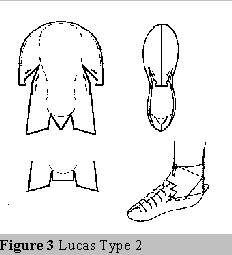 amazing when one considers that for many of the shoes, it is cut out of one piece of leather.
amazing when one considers that for many of the shoes, it is cut out of one piece of leather.
After completing the sewing and cutting of the lacing holes, I used a leather grooving tool to make the design
on the shoe. According to what I have read, designs on some specimens were incised on the surface of the shoe.
I used a similar design to one of the illustrations.
Lucas Type 2
This shoe is one of forty similar specimens. It is elegantly cut and has a center seam running from the toe
to the top of the instep. Like the Type one it has a little tag that extends up the foot above the ankle. Gut was
used to sew the toe and heels seams but thonng was used to sew the flap on the heel. Shoes of this type may or
may not be decorated. Incising of the leather and possibly painting were used.
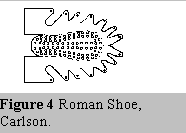 Early Roman
Shoe
Early Roman
Shoe
The early Roman shoe has also been called the Romano-Celtic shoe in some documents that I have seen. This type
of shoe was formed of one piece of leather with a hobnailed sole attached at times. Especially for the Romans.
This style of shoe is very early and is also the pattern used for later-era gillies (post SCA period).
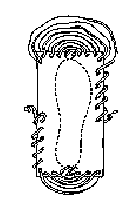
Pampootie
This style of shoe was still in use in the 20th C in the Aran Islands. The type of shoe is reminiscent
of early style shoes worn in Ireland and possibly in Scotland. The shoe is made from a rectangular piece of untanned
hide and is simply drawn up onto the foot with a piece of thong.
From Hald we have an actual account of the shoe's construction. The maker fetched two rectangular pieces of
cowhide some 15 x 28 cm in size. With a pocket knife lacing holes were cut. Approximately one meter of string was
cut for each shoe to lace it. The cowhide was prepared by lightly scraping the flesh with a flat stone. It was
then rubbed with salt and left for a time. Not less than a fortnight. The hide could then be used for shoes.
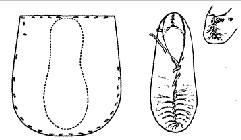 Drumacoon
Bog Shoe
Drumacoon
Bog Shoe
One of the few Scottish shoes found to date is very similar to this shoe found in the Drumacoon Bog in Ireland.
The shoe is formed from one piece of leather and is drawn up over the foot as in the other examples shown.
Conclusion
Many differnet styles of shoes were constructed by the early Celts. If you are able to find a copy of Hald's
book you will find many examples of early types of shoes that were worn throughout northern Europe. If you have
a later period Celtic persona, say after 1000 AD, you should look into the standard shoes worn by the Anglo-saxons,
the Normans and later period English. The book Shoes and Pattens will be indispensible for these types of shoes.
Master Drusilus is also a very good source of information and instruction on making these types of shoes.
Sources
Dunlevy, Mairead -- Dress in Ireland, Holmes & Meiers Publishers, Inc. 1989.
Waterer, John W. -- Leather Craftsmanship, Frederick A Praeger, Publishers. 1968
Carlson, I. Marc -- Historical Shoe Designs/Number 1, http://www.pbm.com/~lindahl/carlson/SHOES/SHOE1.HTM
Hald, Margrethe -- Primitive Shoes, The National Museum of Denmark. 1972.
 The early Irish were
wont to always wear shoes, as they showed a person's position in society. The more refined shoes were constructed
of leather cut from one piece and were sewn with an ornate seam. The shoes were decorated with interlacing or with
designs cut into the surface of the leather. A number of fine examples of early shoes have been found in bogs.
The one pictured to the right is detailed by Dr. A. T. Lucas in the Journal of the County Louth Archaeological
Society (Vol. XIII, 1956, p. 367). Other shoes similar to this type are shown in Leather Craftsmanship by
Waterer and by I. Marc Carlson on his period footwear web pages. The general date of this type of shoe is from
approximately 700-900 of the Common Era.
The early Irish were
wont to always wear shoes, as they showed a person's position in society. The more refined shoes were constructed
of leather cut from one piece and were sewn with an ornate seam. The shoes were decorated with interlacing or with
designs cut into the surface of the leather. A number of fine examples of early shoes have been found in bogs.
The one pictured to the right is detailed by Dr. A. T. Lucas in the Journal of the County Louth Archaeological
Society (Vol. XIII, 1956, p. 367). Other shoes similar to this type are shown in Leather Craftsmanship by
Waterer and by I. Marc Carlson on his period footwear web pages. The general date of this type of shoe is from
approximately 700-900 of the Common Era.  The hardest part in
the process of making this shoe was interpreting the various pictures and brief descriptions of the shoes in question.
Both Waterer and Carlson mention that sinew or gut was used in the construction. Carlson also mentions that thonging
was used for the heel.
The hardest part in
the process of making this shoe was interpreting the various pictures and brief descriptions of the shoes in question.
Both Waterer and Carlson mention that sinew or gut was used in the construction. Carlson also mentions that thonging
was used for the heel.  amazing when one considers that for many of the shoes, it is cut out of one piece of leather.
amazing when one considers that for many of the shoes, it is cut out of one piece of leather. Early Roman
Shoe
Early Roman
Shoe
 Drumacoon
Bog Shoe
Drumacoon
Bog Shoe